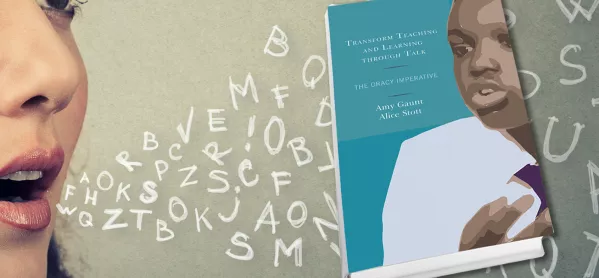- Home
- Book review: Transform Teaching and Learning Through Talk
Book review: Transform Teaching and Learning Through Talk

Transform Teaching and Learning Through Talk
Authors: Amy Gaunt and Alice Stott
Publisher: Rowan and Littlefield
Details: £15.95, paperback, 178pp
ISBN:9781475840681
In this era of cutting-edge edtech, when pupils in some parts of the US are hooked on to online platforms, or, in this country, are increasingly being taught from scripted lessons, the publication of a book beating the drum for a dominant oracy framework for teaching and learning might be seen as an anachronism. For the converted, it’s a timely contribution to the education debate.
There is a lot to like about this book, not least its authors’ attempt to undo the damage caused by the government edict that ejected the speaking and listening component of English language from the mainstream GCSE qualification. The standalone qualification has little vocational value for employers and for results-focused English departments the temptation to get the oral out of the way as soon as possible is too strong - to their pupils’ detriment.
Amy Gaunt and Alice Stott draw on research by Robin Alexander that demonstrates that “quality classroom talk has a measurable impact on academic attainment”. Referring to national statistics that show how social deprivation affects language acquisition, they strengthen the case for an oracy strategy that will enable schools to close the gap between the haves and the have-nots.
Academic results are not the only factor in enhanced career advancement. Opportunities fall at the feet of the most articulate - usually from more privileged backgrounds, as seen by the premium that fee-paying parents place on such skills. The case for academic, social and employment equalisation is well-made at the beginning of the book - an excellent rationale for investing in language-rich classrooms.
The Cambridge Oracy Framework
As a beginning teacher, I would have given this book prime place on my bookshelf and raided it frequently for classroom ideas. There are plenty of activities to try. These start off quite gently in ways that will acquaint teachers and pupils with the four strands of the Cambridge Oracy Framework: physical (voice and body language), linguistic (rhetorical techniques, vocabulary and language), cognitive (content, structure, clarifying and summarising and reasoning), social and emotional (working with others, listening and responding, confidence in speaking and audience awareness) - the soft skills so prized by employers. These strands are addressed initially one at a time.
There are all the right buzz-phrases about students taking ownership of their own learning, unlocking and deepening their understanding and having greater agency in the classroom.
Of course, these benefits don’t come without risk, particularly for the beginner and the underconfident teachers who are just beginning to take control of their classroom. Embracing the Oracy Framework means the teacher relinquishing the place at the front and handing over some of the control to group-work.
The writers do not just offer ideas, though; they also provide strategies for teachers to elicit responses and channel pupils’ efforts through sentence starters, scaffold phrases in a kind of script that can be used by even the most amateur. The attention to detail includes suggestions for group structures with clear evaluation of the strengths and drawbacks of each arrangement. Gaunt and Stott even provide six discussion roles to allocate to students according to their strengths. Recognising the particularly difficult problem of involving quiet, introverted pupils in the activities, they suggest casting such children in the role of silent summariser.
Anecdotes provide insight into the riskier ventures of real situations, such as the class visit to the Mayor of London’s Question Time - and the cognitive benefits as the children took in the physical clues in the speeches and absorbed more complex vocabulary. As Stott points out, reading the minutes would have mystified rather than informed her class.
It is inspiring stuff that seems to have all bases covered: well-pitched and substantiated, systematic and convincingly argued. As an experienced teacher, I appreciate the nuanced way in which the writers differentiate between the performative aspects, the end result of oracy and using oracy for learning, the distinction between quantity and quality. The chapter on organising and running class debates is particularly helpful to those involved in co-curricular public speaking beyond the classroom.
The book is well-structured, drawing on a wide range of personal and academic expertise. The bibliography includes the most influential thinkers and researchers for every teacher to dip into. Just occasionally, the placing of text boxes interrupted the flow of the book’s main discourse, splitting sentences sometimes by a whole double spread, which was a minor irritant. I would have preferred the section on listening to appear rather sooner in the contents, but in these assessment-led times a pedagogical handbook that leaves formal assessment to the end has to be a winner.
This book has the capacity to be influential through its carefully paced practical pedagogy. It’s not necessarily ground-breaking, but it does nicely define the landscape. It sets out the activities with the ordered precision of an Elizabethan gardener, and provides a wealth of ideas clearly linked to the four strands of the Oracy Framework that the authors, their organisations and Cambridge University have evolved over the years, justifying the ringing endorsements on the back cover.
Yvonne Williams is head of English and drama at a school in the south of England
Keep reading for just £1 per month
You've reached your limit of free articles this month. Subscribe for £1 per month for three months and get:
- Unlimited access to all Tes magazine content
- Exclusive subscriber-only stories
- Award-winning email newsletters



